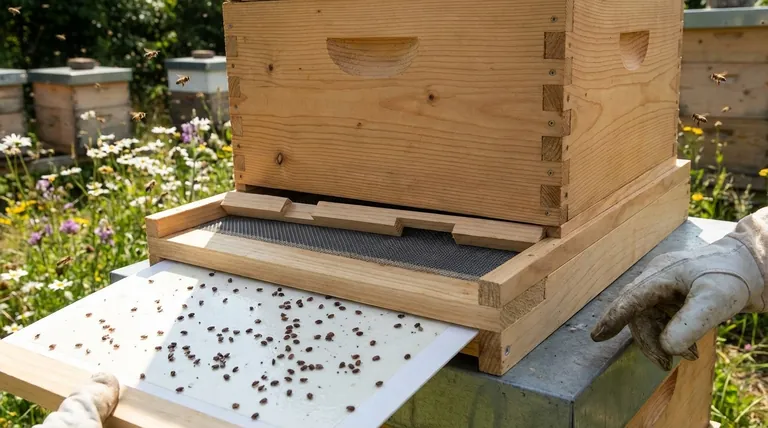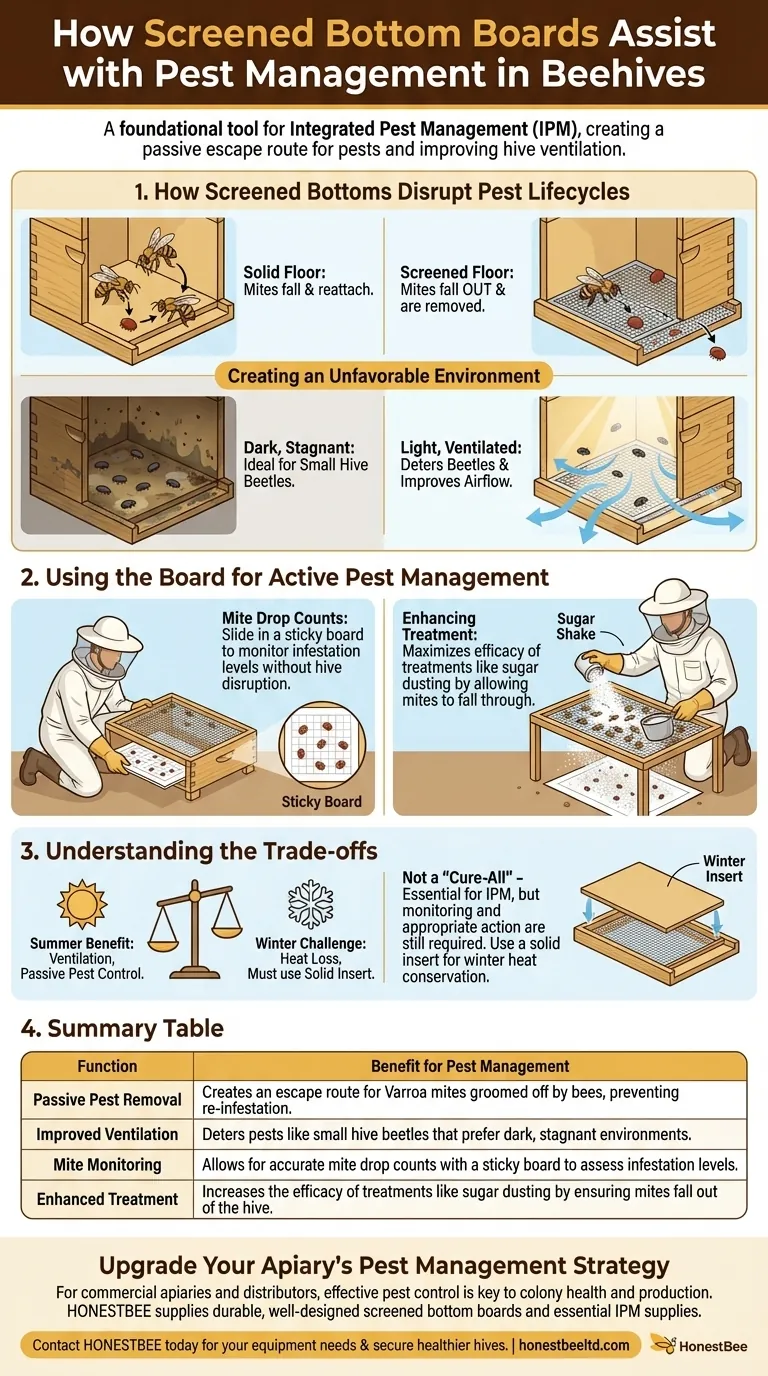In short, screened bottom boards assist with pest management by creating a passive escape route for pests like Varroa mites to fall out of the hive. When bees groom themselves, dislodged mites drop through the mesh floor, preventing them from reattaching to another host. This design also improves hive ventilation, which deters other pests like small hive beetles that prefer dark, stagnant conditions.
A screened bottom board is not a treatment in itself, but a foundational tool for Integrated Pest Management (IPM). It works by changing the hive's physical environment to be less hospitable to pests and gives the beekeeper a clear window for monitoring infestation levels.

How Screened Bottoms Disrupt Pest Lifecycles
A screened bottom board fundamentally alters the hive floor from a solid surface to a permeable one. This simple change has a direct impact on the pests that threaten a colony's health.
Leveraging Natural Bee Behavior
Bees are hygienic insects and actively try to remove pests from their bodies through grooming. A solid bottom board allows a dislodged mite to simply fall to the floor and wait to climb onto a new bee.
A screened bottom board breaks this cycle. When a mite is groomed off, it falls completely out of the hive, permanently removing it from the colony.
Creating an Unfavorable Environment
Small hive beetles thrive in dark, humid environments with poor air circulation. A screened bottom board introduces light and increases airflow throughout the hive.
This ventilation makes the hive a far less attractive breeding ground for beetles, passively discouraging them from establishing a population.
Using the Board for Active Pest Management
Beyond its passive benefits, a screened bottom board is a powerful diagnostic tool that enables the beekeeper to take precise, informed action.
Performing Mite Drop Counts
Most screened bottom boards come with a removable solid insert, often called a "sticky board" or monitor board. By sliding this board in for a 24- or 72-hour period, you can count the number of mites that naturally fall.
This "mite drop count" is one of the most effective ways to estimate the total Varroa mite population within the hive without causing major disruption. It tells you when and if more aggressive treatment is necessary.
Enhancing Treatment Efficacy
Certain treatments are more effective when used with a screened bottom. For example, the "sugar shake" method involves dusting bees with powdered sugar to encourage intense grooming.
The screened floor ensures that the mites dislodged during this process fall out of the hive, maximizing the treatment's impact. It also allows you to place sticky boards underneath to catch and trap pests.
Understanding the Trade-offs
While highly beneficial, screened bottom boards are not a universal solution and come with important considerations.
The Myth of a "Cure-All"
A screened bottom board is a tool for management, not a cure. While it helps reduce mite numbers, it will not eliminate them. Beekeepers must still monitor infestation levels and be prepared to intervene with appropriate treatments when mite counts exceed established thresholds.
Wintering Challenges
The primary benefit of a screened bottom board in the summer—ventilation—becomes its primary liability in the winter. The increased airflow can make it much harder for the colony to maintain its crucial winter cluster temperature.
In cold climates, the screen must be closed off with a solid insert or winter board to help the bees conserve heat and energy. Failure to do so can severely stress or kill a colony.
Making the Right Choice for Your Goal
Integrating a screened bottom board into your beekeeping practice depends on your climate and specific management objectives.
- If your primary focus is accurate mite monitoring: A screened bottom board with a removable insert is essential for performing regular mite drop counts.
- If your primary focus is passive pest reduction in a hot climate: An open screened bottom is an excellent choice for providing ventilation and allowing mites to fall out naturally.
- If your primary focus is overwintering hives in a cold climate: Use a screened bottom board, but ensure you have a solid insert to close it off completely and conserve hive heat.
Ultimately, a screened bottom board empowers you with more information and a greater degree of control over your hive's health.
Summary Table:
| Function | Benefit for Pest Management |
|---|---|
| Passive Pest Removal | Creates an escape route for Varroa mites groomed off by bees, preventing re-infestation. |
| Improved Ventilation | Deters pests like small hive beetles that prefer dark, stagnant environments. |
| Mite Monitoring | Allows for accurate mite drop counts with a sticky board to assess infestation levels. |
| Enhanced Treatment | Increases the efficacy of treatments like sugar dusting by ensuring mites fall out of the hive. |
Upgrade Your Apiary's Pest Management Strategy
For commercial apiaries and beekeeping equipment distributors, effective pest control is non-negotiable for colony health and honey production. HONESTBEE supplies the durable, well-designed screened bottom boards and other essential beekeeping supplies you need to implement a successful Integrated Pest Management (IPM) program.
Let our wholesale-focused operations help you protect your investment. Contact HONESTBEE today to discuss your equipment needs and secure healthier, more productive hives.
Visual Guide

Related Products
- Langstroth Screen Bottom Board for Beekeeping Wholesale
- Australian Pine Wood Langstroth Screen Bottom Board for Wholesale
- HONESTBEE Wooden Bee Escape Board with Triangle Mesh Design for Beekeeping
- Professional Galvanized Hive Strap with Secure Locking Buckle for Beekeeping
- HONESTBEE Professional Frame Wiring Board and Jig
People Also Ask
- What are the benefits of a screened bottom board? Boost Hive Health & Control Varroa Mites
- What are the benefits of using a screened bottom board for beehives? Improve Ventilation & Mite Control
- What is the primary function of a screened bottom board in a hive? Enhance Ventilation & Control Varroa Mites
- What are the assembly options for the Cypress Screened Bottom Board? Ready-to-Use for Immediate Hive Health
- What are the benefits of using a screened bottom board in warm or humid climates? Boost Hive Health & Control Pests



















